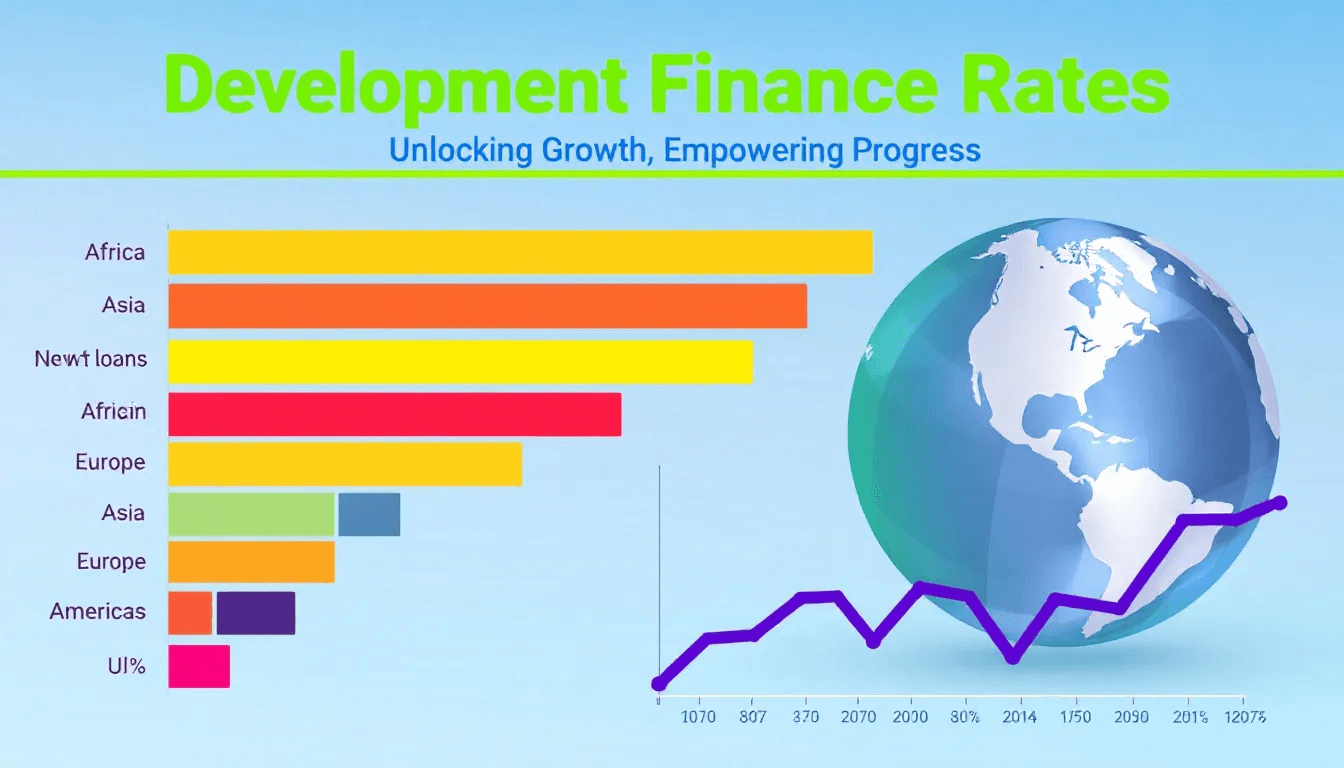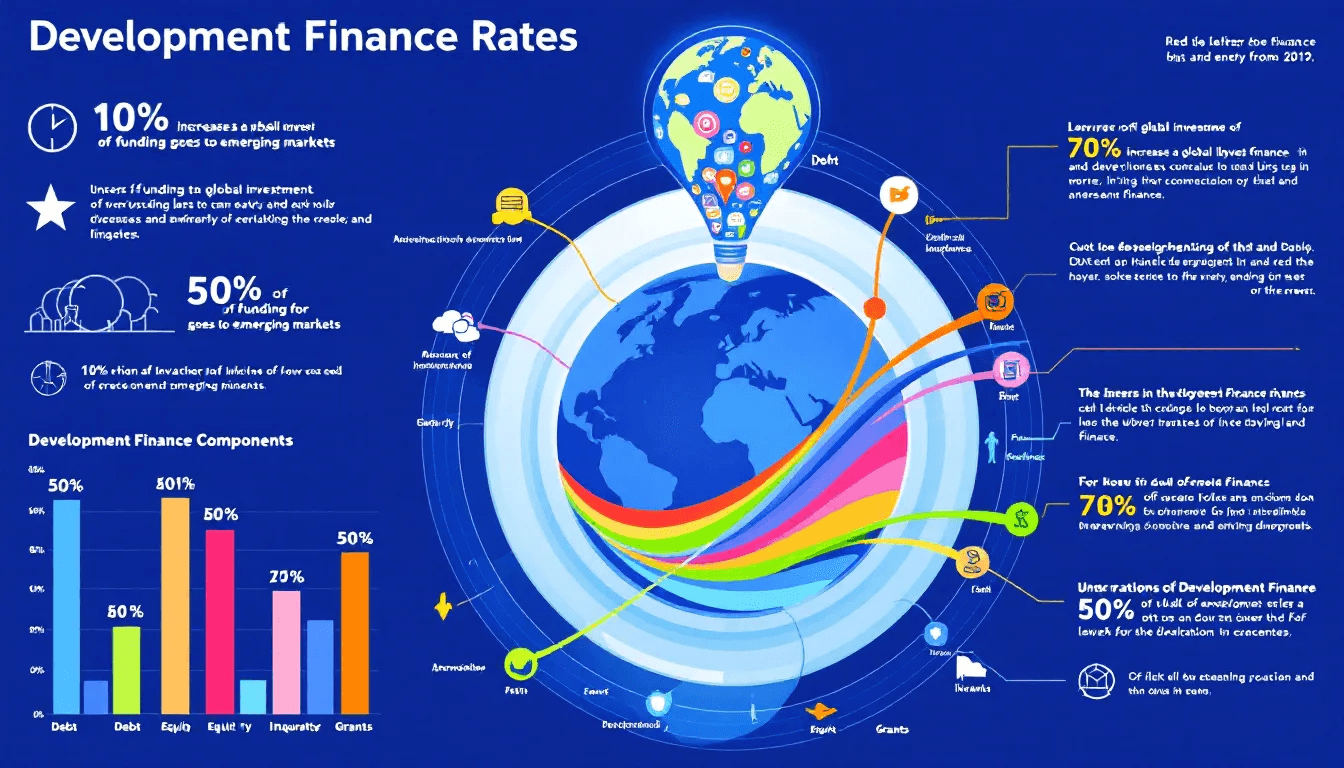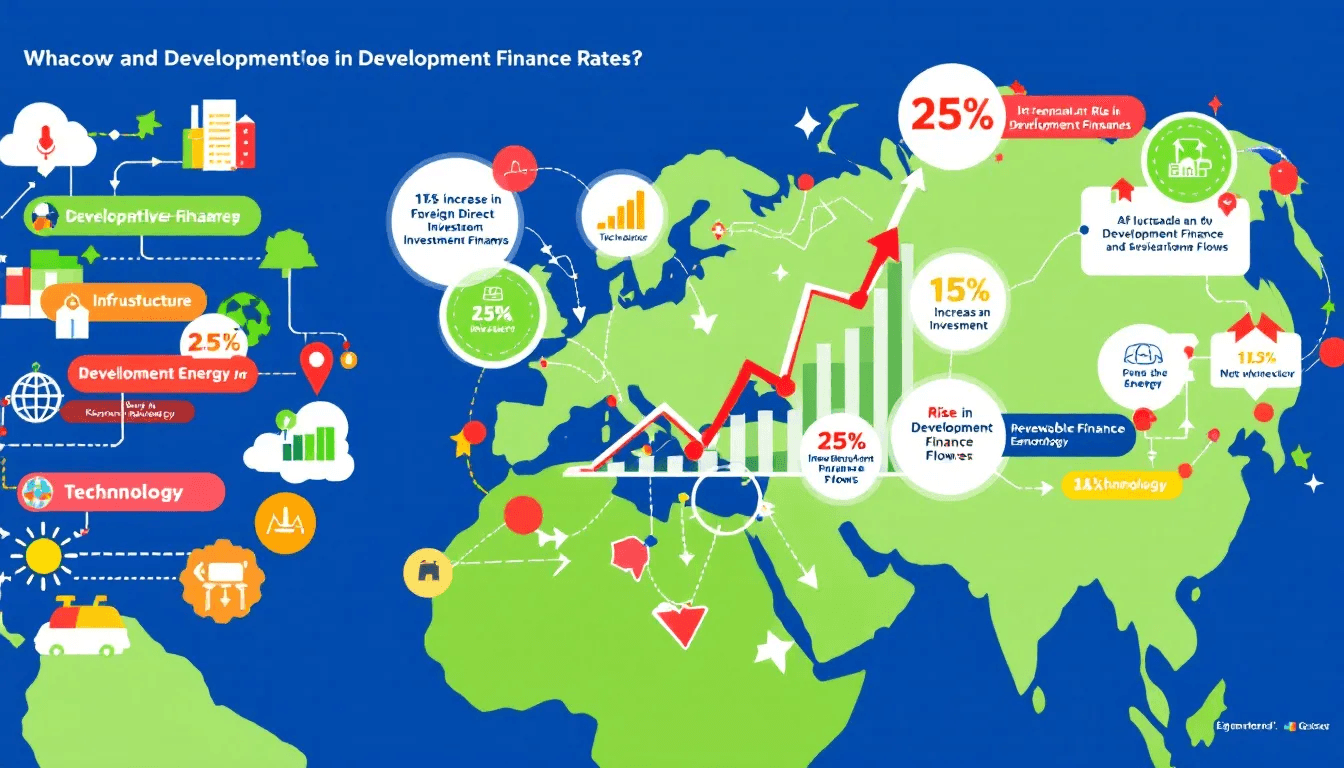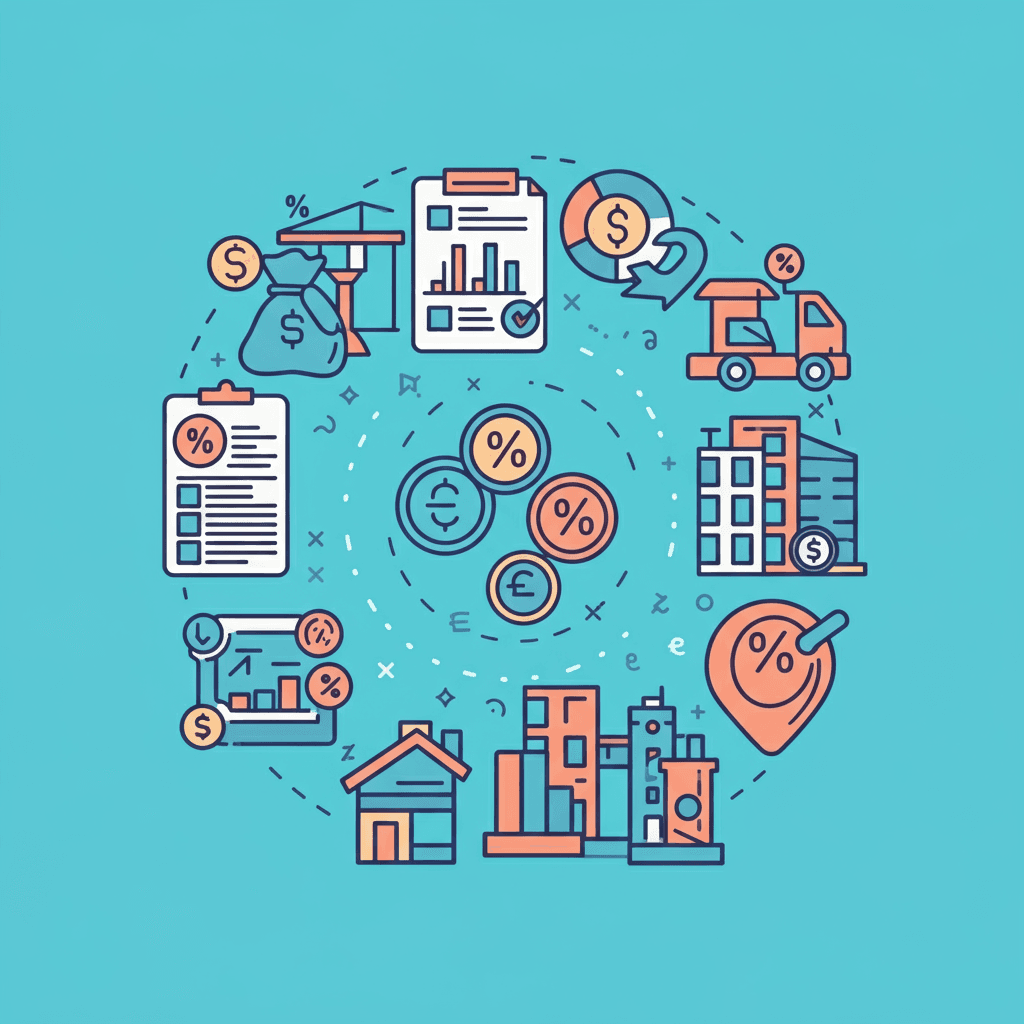Current development finance rates, as of early 2025, range from 4% to 4.5% per annum. These rates impact your project’s overall cost and feasibility. Understanding these rates, what influences them, and how to secure the best terms can significantly affect your development’s success.
Key Takeaways
- Development finance rates typically range from 4% to 4.5% per annum, influenced by various factors such as the lender’s risk appetite and project specifics.
- Key factors affecting development finance rates include the borrower’s credit history, the developer’s experience, and the project location and type.
- To secure favorable development finance rates, developers should improve creditworthiness, develop a strong business plan, and compare offers from multiple lenders.
Overview of Development Finance Rates
Development finance rates are a crucial aspect of property development finance that every developer must understand. As of early 2025, these rates typically range between 4% and 4.5% per annum, reflecting the complexities and risks associated with construction and payment challenges. Unlike standard property finance, development finance interest rates tend to be higher due to the unpredictable nature and multifaceted requirements of development projects. Developers must grasp the current rates and available options to make well-informed financial decisions.
The variation in development finance rates is influenced by numerous factors, including the lender’s risk appetite and the specifics of the project. Many development finance loans feature variable interest rates, which means that the repayment amounts can fluctuate over time. This can add another layer of complexity to financial planning, underscoring the importance of thorough research and strategic planning in securing the best possible rates.

Average Interest Rates for Development Finance Loans
When exploring development finance loans, it’s essential to understand the average interest rates and how they can vary. Typically, these rates fall between:
- 0.33% and 1% per month, which translates to an annual rate ranging from approximately 4% to 12%
- On average, property developers can expect a monthly interest rate of about 0.6%, equivalent to an annual rate of around 7%
- However, for loans under £1 million, interest rates generally range from 4% to 7.5% annually
The interest rates for development finance loans can significantly depend on the loan amount and the perceived risk of the project. Loans exceeding £1 million rarely have rates below 6%, while high-risk or smaller loans may see monthly rates as high as 1.35%, leading to annual loans interest rates up to 16.2%.
Understanding these averages helps property developers plan their financial projections more accurately and ensures they are prepared for the costs associated with their development loans.
Key Factors Influencing Development Finance Rates
Several key factors influence development finance rates, affecting the cost and terms of development finance loans. These include:
- The borrower’s credit history
- The developer’s experience
- The project’s location and type
- Overall market conditions
- Lender policies
- The specifics of the project
These factors play crucial roles in determining the interest rates.
Understanding these factors can help developers better prepare and potentially secure more favorable rates.

Borrower’s Credit History
A borrower’s credit history is a significant determinant of the interest rates on development loans. A favorable credit history demonstrates reliability and financial responsibility, often leading to lower interest rates. A poor credit score can lead to higher rates. This is because lenders perceive an increased risk. Therefore, maintaining a clean credit history is crucial for securing favorable loan terms. Regularly monitoring your credit score, ensuring its accuracy, and addressing any issues promptly are essential steps in this process.
Developers should pay off any existing debt secured to maintain a favorable credit report. Additionally, they should avoid taking on new credit prior to applying for a development finance loan. By doing so, they can enhance their creditworthiness, which plays a crucial role in influencing the loan rates they can secure.
This proactive approach can significantly improve the chances of obtaining better financing terms and ultimately reduce the overall cost of the development project.
Developer Experience
The experience of the developer is another critical factor affecting development finance rates. More experienced developers are generally able to secure better rates due to their proven track record of successful projects. Lenders perceive experienced developers as lower risk, which translates into more favorable interest rates on property development loans. In contrast, new or less experienced developers often face higher rates due to the increased perceived risk associated with their projects.
Lenders favor developers who have demonstrated their ability to complete projects successfully and manage the various challenges that come with property development. This preference for experienced developers underscores the importance of building a robust portfolio and gaining practical experience in the field.
For new developers, partnering with experienced professionals or leveraging mentorship opportunities can be valuable strategies to improve their standing with development lenders.

Project Location and Type
The location and type of the development project are pivotal in determining development finance rates. Projects situated in prime locations often attract lower rates due to the higher likelihood of success and faster sales or rentals. On the other hand, projects located in less desirable areas might encounter higher rates. This is often due to the increased risk associated with those locations. Additionally, the type of project – whether residential and commercial projects or residential – influences financing. Commercial projects typically encounter higher interest rates compared to standard residential developments because of the perceived higher risks associated with them.
Loan-to-value (LTV) ratios also play a critical role in setting loan interest rates. Higher LTV ratios typically lead to increased rates due to the greater risk they present for lenders. Consulting with specialist lenders and brokers can provide tailored rate options that suit the specific project type and location, ensuring more accurate financial projections and better planning.
Calculating Development Finance Rates
Calculating development finance rates involves several considerations, starting with the project’s complexity. Projects requiring extensive regulatory approvals or facing significant challenges are perceived as higher risk, leading to higher interest rates. A well-crafted business plan can significantly influence negotiations for better loan terms. This plan should include a detailed risk management strategy to address the risk involved in potential project challenges and instill confidence in lenders.
The Gross Development Value (GDV) is another critical factor, reflecting the anticipated value of the completed project. Interest on development loans can be calculated on a monthly or yearly basis, depending on the agreement with the lender.
For larger loan amounts, the maximum business loan available can reach up to 90% of the total project costs, providing substantial financial support for ambitious developments. Presenting a comprehensive and detailed project plan, along with obtaining necessary planning permissions, can greatly enhance the likelihood of securing favorable terms and rates for a bridging loan.
Drawdown Facilities in Development Finance
Drawdown facilities offer a flexible financing solution for property developers, allowing them to borrow different amounts at various stages of the project. This type of financing means that interest is only paid on the amounts drawn, which can significantly reduce upfront costs. Drawdown facilities are typically approved faster than traditional loans, often with online processing, making them an attractive option for developers needing quick access to funds through a development finance facility.
Interest on drawdown facilities is usually charged daily on the amount drawn, with rates ranging from 0.05% to 0.1%. This approach allows developers to manage their cash flow more effectively and minimize unnecessary interest payments while keeping track of interest paid by only borrowing as needed to pay interest as needed.
Moreover, interest payments can be rolled up until the end of the loan, providing additional financial flexibility during the development phase. Utilizing drawdown facilities can help developers maintain better control over their project finances and ensure smoother project execution.

Additional Fees in Development Finance
In addition to interest rates, property development finance often involves various additional fees that can impact the overall cost of the property development loan. Arrangement fees typically range from 1% to 2% of the loan amount, adding a significant cost component. Exit fees, which are charged at the end of the loan term, generally range from 0% to 2% of the total loan amount or the Gross Development Value (GDV). These fees must be factored into the overall financial planning for the project.
Valuation fees are another common charge, although there is no standard fee structure, and these costs can vary widely. A valuation fee and additional professional fees, such as those for architects, solicitors, and project managers, as well as non-utilisation fees, can further increase the total repayment amount.
Collectively, these additional fees elevate the effective development finance rate, making it essential for developers to consider them in their financial projections. By understanding these fees, developers can better prepare their budgets and manage the financial aspects of their projects more effectively.
How to Secure the Best Development Finance Rates
To secure the best development finance rates, strategic planning is essential. Additionally, a thorough understanding of the lending landscape is necessary. Key strategies include improving creditworthiness, developing a strong business plan, and comparing multiple lenders. Each of these approaches can significantly influence the interest rates and terms offered by lenders, ultimately reducing the overall cost of the development finance loan.
The following subsections will delve into these strategies in more detail.
Improve Creditworthiness
Improving creditworthiness is a fundamental step in securing favorable interest rates on development finance loans. A strong credit history can lead to lower interest rates, while a poor credit score typically results in higher rates due to the increased perceived risk. Developers should focus on maintaining a clean credit history by paying off existing debts, avoiding new credit, and ensuring the accuracy of their credit report. For more insights, refer to our business credit scoring guide.
By enhancing their creditworthiness, developers can significantly improve their chances of securing better loan conditions. This proactive approach not only helps in obtaining lower interest rates but also strengthens the overall financial health of the developer, making future financing easier and more affordable.

Develop a Strong Business Plan
Developing a strong business plan is crucial for securing better financing terms. A detailed business plan demonstrates that developers are well-prepared to represent their projects, which can lead to more favorable rates. This plan should include comprehensive financial projections, a thorough risk management strategy, and a clear exit strategy to instill confidence in lenders.
Primary factors like credit history, developer experience, and project specifics considerably influence financing rates. By presenting a well-crafted business plan, developers can highlight their preparedness and reduce the perceived risk, thereby securing better financing rates and terms.
This strategic approach can make a significant difference in the overall cost and success of the property development project.
Compare Multiple Lenders
Comparing offers from multiple lenders is essential for finding the best rates and terms. Different lenders have varying policies, risk appetites, and offers, so exploring multiple options can reveal the most competitive terms available. Evaluating the repayment terms, interest rates, and additional fees from various lenders helps developers make informed decisions that align with their financial goals.
By taking the time to compare multiple lenders, developers can identify the best available deals and potentially secure lower interest rates and more favorable loan terms. This approach ensures that developers are not overpaying for their financing and can allocate their resources more efficiently towards their property development projects.
Role of Development Finance Brokers
Development finance brokers play a crucial role in helping developers secure favorable loan rates and terms. These professionals streamline the application process, manage communications with lenders, and provide valuable insights into lender preferences and market conditions. By leveraging their expertise and connections, brokers can increase the likelihood of loan approval and negotiate competitive rates on behalf of developers.
Brokers often have access to a wider range of lending options compared to individual developers, making it easier to find suitable financing solutions for specific project needs, including a commercial mortgage and bridging loans. They evaluate project viability, match developers with appropriate lenders, and negotiate the most advantageous finance packages.
While broker fees are typically around 1% of the loan amount, the benefits they provide in securing better terms and rates often outweigh the broker fee.

Market Trends for Development Finance Rates
As of early 2025, development finance rates in the UK have decreased to approximately 4% to 4.5% per year, down from around 5% at the end of 2024. This reduction reflects favorable market conditions and increased competition among lenders, which can lead to more attractive rates for developers. However, market conditions such as economic stability, interest rate trends, and the overall health of the property market are vital factors affecting these rates in uk property finance.
In stable or growing markets, lenders are more inclined to offer competitive rates, while uncertain economic conditions can lead to increased caution and higher rates. Understanding these market trends and incorporating them into financial planning can help developers secure the most competitive rates available.
A comprehensive strategy and insight into lending trends are essential for navigating the development finance market effectively.
Summary
Understanding development finance rates is essential for any property developer looking to navigate the financial landscape effectively. By grasping the average interest rates, key factors influencing these rates, and the importance of strategic planning, developers can make more informed decisions that impact the success and profitability of their projects. The role of credit history, developer experience, and project specifics cannot be overstated, as these elements significantly shape the terms and cost of development finance loans.
Additionally, utilizing drawdown facilities, being mindful of additional fees, and leveraging the expertise of development finance brokers are crucial strategies for optimizing financial outcomes. Keeping an eye on market trends and comparing multiple lenders ensures that developers secure the most competitive rates available. By applying these insights, developers can enhance their financial planning, reduce costs, and ultimately achieve greater success in their property development ventures.

Frequently Asked Questions
What are the typical interest rates for development finance loans?
Typical interest rates for development finance loans range from 0.33% to 1% monthly, resulting in an annual rate of approximately 4% to 12%.
How does a borrower’s credit history affect development finance rates?
A borrower’s credit history significantly influences development finance rates, as a favorable credit history can result in lower interest rates, whereas a poor credit score usually leads to higher rates due to increased perceived risk.
What is a drawdown facility in development finance?
A drawdown facility enables developers to access varying amounts of financing at different project stages, thus incurring interest solely on the drawn amounts and minimizing initial costs. This mechanism enhances financial flexibility throughout the project’s lifecycle.
What additional fees should be considered in development finance?
It is essential to consider arrangement fees (1% to 2% of the loan amount), exit fees (0% to 2% of the loan amount or GDV), valuation fees, and professional fees for architects, solicitors, and project managers when navigating development finance. These additional costs can significantly impact the overall financial planning of your project.
How can developers secure the best development finance rates?
To secure the best development finance rates, developers should enhance their creditworthiness, create a robust business plan, compare multiple lenders, and consider consulting with development finance brokers. This comprehensive approach can lead to more favorable financial terms.



